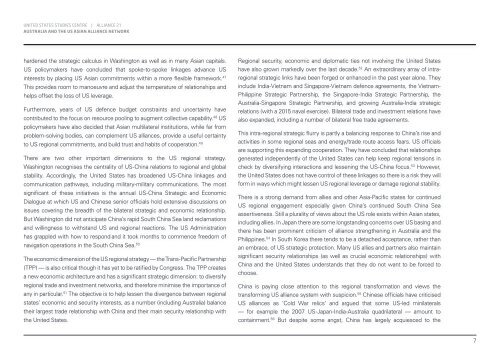ALLIANCE NETWORK
A21AsiaReport
A21AsiaReport
Create successful ePaper yourself
Turn your PDF publications into a flip-book with our unique Google optimized e-Paper software.
UNITED STATES STUDIES CENTRE | <strong>ALLIANCE</strong> 21<br />
AUSTRALIA AND THE US ASIAN <strong>ALLIANCE</strong> <strong>NETWORK</strong><br />
hardened the strategic calculus in Washington as well as in many Asian capitals.<br />
US policymakers have concluded that spoke-to-spoke linkages advance US<br />
interests by placing US Asian commitments within a more flexible framework. 47<br />
This provides room to manoeuvre and adjust the temperature of relationships and<br />
helps offset the loss of US leverage.<br />
Furthermore, years of US defence budget constraints and uncertainty have<br />
contributed to the focus on resource pooling to augment collective capability. 48 US<br />
policymakers have also decided that Asian multilateral institutions, while far from<br />
problem-solving bodies, can complement US alliances, provide a useful certainty<br />
to US regional commitments, and build trust and habits of cooperation. 49<br />
There are two other important dimensions to the US regional strategy.<br />
Washington recognises the centrality of US-China relations to regional and global<br />
stability. Accordingly, the United States has broadened US-China linkages and<br />
communication pathways, including military-military communications. The most<br />
significant of these initiatives is the annual US-China Strategic and Economic<br />
Dialogue at which US and Chinese senior officials hold extensive discussions on<br />
issues covering the breadth of the bilateral strategic and economic relationship.<br />
But Washington did not anticipate China’s rapid South China Sea land reclamations<br />
and willingness to withstand US and regional reactions. The US Administration<br />
has grappled with how to respond and it took months to commence freedom of<br />
navigation operations in the South China Sea. 50<br />
The economic dimension of the US regional strategy — the Trans-Pacific Partnership<br />
(TPP) — is also critical though it has yet to be ratified by Congress. The TPP creates<br />
a new economic architecture and has a significant strategic dimension: to diversify<br />
regional trade and investment networks, and therefore minimise the importance of<br />
any in particular. 51 The objective is to help lessen the divergence between regional<br />
states’ economic and security interests, as a number (including Australia) balance<br />
their largest trade relationship with China and their main security relationship with<br />
the United States.<br />
Regional security, economic and diplomatic ties not involving the United States<br />
have also grown markedly over the last decade. 52 An extraordinary array of intraregional<br />
strategic links have been forged or enhanced in the past year alone. They<br />
include India-Vietnam and Singapore-Vietnam defence agreements, the Vietnam-<br />
Philippine Strategic Partnership, the Singapore-India Strategic Partnership, the<br />
Australia-Singapore Strategic Partnership, and growing Australia-India strategic<br />
relations (with a 2015 naval exercise). Bilateral trade and investment relations have<br />
also expanded, including a number of bilateral free trade agreements.<br />
This intra-regional strategic flurry is partly a balancing response to China’s rise and<br />
activities in some regional seas and energy/trade route access fears. US officials<br />
are supporting this expanding cooperation. They have concluded that relationships<br />
generated independently of the United States can help keep regional tensions in<br />
check by diversifying interactions and lessening the US-China focus. 53 However,<br />
the United States does not have control of these linkages so there is a risk they will<br />
form in ways which might lessen US regional leverage or damage regional stability.<br />
There is a strong demand from allies and other Asia-Pacific states for continued<br />
US regional engagement especially given China’s continued South China Sea<br />
assertiveness. Still a plurality of views about the US role exists within Asian states,<br />
including allies. In Japan there are some longstanding concerns over US basing and<br />
there has been prominent criticism of alliance strengthening in Australia and the<br />
Philippines. 54 In South Korea there tends to be a detached acceptance, rather than<br />
an embrace, of US strategic protection. Many US allies and partners also maintain<br />
significant security relationships (as well as crucial economic relationships) with<br />
China and the United States understands that they do not want to be forced to<br />
choose.<br />
China is paying close attention to this regional transformation and views the<br />
transforming US alliance system with suspicion. 55 Chinese officials have criticised<br />
US alliances as ‘Cold War relics’ and argued that some US-led minilaterals<br />
— for example the 2007 US-Japan-India-Australia quadrilateral — amount to<br />
containment. 56 But despite some angst, China has largely acquiesced to the<br />
7


